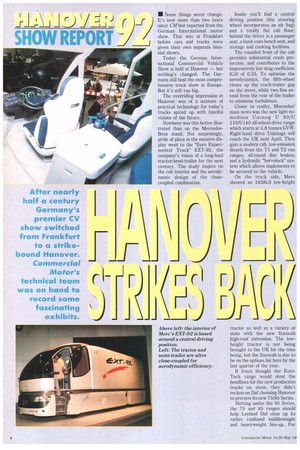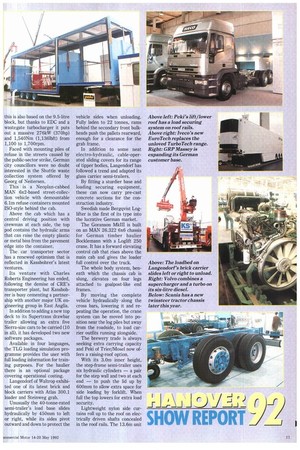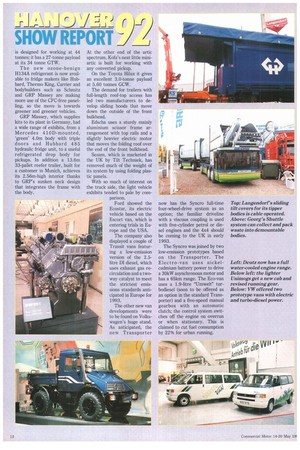SHOW REPORT
Page 10

Page 11

Page 12

Page 13

Page 14

If you've noticed an error in this article please click here to report it so we can fix it.
• Some things never change. It's now more than two years since CM last reported from the German International motor show. That was at Frankfurt before cars and trucks were given their own separate biennial shows.
Today the German International Commercial Vehicle Show is held at Hanover — but nothing's changed. The Germans still host the most comprehensive truck show in Europe. But it's still too big.
The overriding impression at Hanover was of a mixture of practical technology for today's trucks spiced up with fanciful visions of the future.
Nowhere was this better illustrated than on the MercedesBenz stand. Not surprisingly, pride of place in the massive display went to the "Euro Experimental Truck" EXT-92, the company's vision of a long-haul tractor/semi-trailer for the next century. The study majors on the cab interior and the aerodynamic design of the closecoupled combination. Inside you'll find a central driving position (the steering wheel incorporates an air bag) and a totally flat cab floor; behind the driver is a passenger seat, a bunk-cum-bench seat, and storage and cooking facilities.
The rounded front of the cab provides substantial crash protection, and contributes to the impressively low drag coefficient (Cd) of 0.35. To optimise the aerodynamics, the fifth-wheel closes up the truck-trailer gap on the move, while two fins extend from the rear of the trailer to minimise turbulence.
Closer to reality, Mercedes' main news was the new light-tomedium Unimog U 90/U 110/U140 all-wheel-drive range which starts at 4.8 tonnes GVW. Right-hand drive Unimogs will reach the UK next April. They gain a modern cab, low-emission diesels from the Ti and T2 van ranges, all-round disc brakes, and a hydraulic "Servolock" system which allows implements to be secured to the vehicle.
On the truck side, Mere showed an 1838LS low-height tractor as well as a variety of units with the new Eurocab high-roof extension. The lowheight tractor is not being brought to the UK for the time being, but the Eurocab is due to be on the options list here by the last quarter of the year.
If Iveco thought the EuroTech range would steal the headlines for the new production trucks on show, they didn't reckon on Daf choosing Hanover to preview its new 75/85 Series.
Slotting under the 95 Series, the 75 and 85 ranges should help Leyland Daf clear up its rather confused middleweight and heavyweight line-up. For full details of the new vehicles, see page 24.
Before UK operators reach for the phone, the bad news is that the 75 and 85 Series won't be available in right-hand-drive for at least 12 months.
Like Mercedes, MAN's display included a look to the fuure, but this one concentrated on the problems of urban distribution. The SLW 2000 7.5-tonner shown as a full-size working prototype, combines a sophisticated front-wheel-drive driveline with all-round hydropneumatic suspension and fourwheel steering.
A split-level frame allows a low floor level in the box body, and there is good access to the load area from the cab. A chargecooled four-cylinder diesel with air injection is mounted horizontally under the floor. It drives via a nine-speed ZF fully automatic transmission so cross-cab movement is unobstructed by an engine-hump or gearlever.
For its production vehicles, MAN's main innovation was the introduction of front-axle disc brakes, initially on its premium .502 F90 models. The company also has a full range of engines engineered to • meet Euro-1 emissions regulations, and its 10-litre five and 12-litre six are available with the option of EDC.
As predicted (CM 5-11 March), Deutz used the show to unveil additions to its new family of water-cooled diesels. They include a 12-litre vee-six, a 16-litre vee-eight, and a 3.0-litre in-line four.
The big turbocharged or charge-cooled FM 1015 series, rated at 250-440kW (335590hp) are clearly aimed at the heavy goods and coach sectors.
Innovations include four valves per cylinder and a centrally located eight-hole fuel injector set for pressures in excess of 1,000bar.
These engines are said to comply with the Euro-1 exhaust emission limits. The FM1015 series will enter production in 1993/4.
The smaller FM1010 diesel churns out 76kW (103hp) in turbo form or 110kW (150hp) when charge-cooled. Deutz believes it will interest many of the light CV manufacturers.
The FM 1010 will mount transversely or fore-and-aft in any of the popular chassis up to 6.0 tonnes GVW; production begins this autumn. Deutz is talking to major manufacturers such as VW, Mercedes, Renault and Leyland Daf and says it has already signed up one customer. If you thought superchargers were a thing of the past on trucks, Volvo's latest concept engine could well make you change your mind: it is fitted with a small mechanically driven supercharger as well as a conventional turbocharger. The double-blown engine is based on the six-litre TD63ES from the FL6 17-tonner. It is claimed to have very low exhaust emissions, especially particulates and hydrocarbons, so even at idle there is no visible smoke.
The extra blower provides a major increase in torque at very low revs — according to Volvo's product strategy manager Anders Johannesson, it can match a seven-litre and even a 10-litre Volvo truck engine.
Volvo is conducting durability tests including in-vehicle trials, but has not yet decided whether to put it into series production.
Volvo's arch-rival Scania also showed a new transmission at Hanover. Its GR801 eight-speed range-change synchro box will become standard on most Scania 93 models, replacing the existing GS771 splitter box.
The GR801 will become available in the UK from this autumn, along with a new twin-steer tractor featuring a lifting midaxle. The 4.1m-wheelbase model on show was slightly longer than the version which will be offered in the UK.
Another newcomer from Scania was the low-height P93MV 220 17-tonner, which replaces the old G chassis.
According to Scania Great Britain, the P93MV chassis will be aimed at high-volume/demount operators, although as we already have the low-height ML chassis with full air, demand is not expected to be high.
Renault showed its R-range (Major) and the AE powered by its 12-litre Advanced Combustion Engine (ACE) which now pumps out 283kW (380hp) (CM 2-8 April 1992), but there is no word on the 313kW (420hp) version for the AE.
RVI will not be drawn on its arrival, but the most obvious launch venue would be the Paris Show in the autumn. Around this time UK operators could also see the facelifted and uprated versions of the 6x4 and 8x4 range multi-wheelers.
Renault's towering AE is undeniably futuristic, but for Hanover the company went one step further by showing an AE tractor with its Commercial Fleet Management System. Among the equipment in a floor-toceiling console was a computer with a printer, a fax, and a Minitel unit for load matching. The CFM system also allows a vehicle to be tracked using the C Loran marine navigation system.
Iveco's stand was dominated by the new EuroTech range of tractors and rigids (previewed in Commerical Motor last week).
The new trucks inherit the family face of the new Cargos and take over from the TurboTech models. From this autumn they will be attempting to boost Iveco Ford's dismal showing in the heavy truck sector.
As well as a new cab, (including an extended roof option), the EuroTechs get front-axle disc brakes, a choice of two and three-axle chassis configurations, an all-round air suspension option and some heavily revised engines.
Model for model the EuroTechs are claimed to be up to 500kg lighter than their predecessors.
Vehicles on the stand featured the 9.5-litre 254kW (341hp) and 13.8-litre 309kW (414hp) variants, badged as the E34 and E42. Not shown, however, were the E38 trucks, which use the most interesting engine option: this is also based on the 9.5-litre block, but thanks to EDC and a wastegate turbocharger it puts out a massive 276kW (370hp) and 1,540Nm (1,136Ibft) from 1,100 to 1,700rpm.
Faced with mounting piles of refuse in the streets caused by the public-sector strike, German city councillors were no doubt interested in the Shuttle waste collection system offered by Georg of Neitersen.
This is a Neoplan-cabbed MAN 6x2-based street-collection vehicle with demountable 6.1m refuse containers mounted ISO-style behind the cab.
Above the cab which has a central driving position with crewman at each side, the top pod contains the hydraulic arms that can raise the empty plastic or metal bins from the pavement edge into the container.
The car transporter sector has a renewed optimism that is reflected in Kassbohrer's latest ventures.
Its venture with Charles Roberts Engineering has ended, following the demise of CRE's transporter plant, but Kassbohrer is busy cementing a partnership with another major UK engineering group in East Anglia.
In addition to adding a new top deck to its Supertrans drawbar trailer allowing an extra five Sierra-size cars to be carried (10 in all), it has developed two new software packages.
Available in four languages, the TLG loading simulation programme provides the user with full loading information for training purposes. For the haulier there is an optional package covering operational costing.
Langendorf of Waltrop exhibited one of its latest brick and block carriers with Atlas 300.1 loader and Steinweg grab.
Unusually the 40-tonne-rated semi-trailer's load base slides hydraulically by 450mm to left or right, while its sides pivot outward and down to protect the vehicle sides when unloading. Fully laden to 22 tonnes, rams behind the secondary front bulkheads push the pallets rearward, enough for a clearance for the grab frame.
In addition to some neat electro-hydraulic, cable-operated sliding covers for its range of tipper bodies, Langendorf has followed a trend and adapted its glass carrier semi-trailers.
By fitting a sturdier base and loading securing equipment, these can now carry pre-cast concrete sections for the construction industry.
Swedish made Bergqvist Loglifter is the first of its type into the lucrative German market.
The Goranson MkIII is built on an MAN 26.322 6x6 chassis for German timber haulier Bocklemann with a Loglift 250 crane. It has a forward elevating control cab that rises above the main cab and gives the loader full control over the truck.
The whole body system, beneath which the chassis cab is slung, elevates on four legs attached to goalpost-like end frames.
By moving the complete vehicle hydraulically along the cross bars, lowering it and repeating the operation, the crane system can be moved into position near the log piles but away from the roadside, to load carrier outfits running alongside.
The brewery trade is always seeking extra carrying capacity and Peki of Trier/Mosel now offers a raising-roof option.
With its 3.0m inner height, the step-frame semi-trailer uses six hydraulic cylinders — a pair for the step wall and two at each end — to push the lid up by 600mm to allow extra space for side loading by forklift. When full the top lowers for extra load security.
Lightweight nylon side cur tains roll up to the roof on electrically driven shafts concealed in the roof rails. The 13.6m unit is designed for working at 44 tonnes; it has a 27-tonne payload at its 34 tonne GTW.
The new ozone-benign H134A refrigerant is now available to fridge makers like Hubbard, Thermo King, Carrier and bodybuilders such as Schmitz and GRP Massey are making more use of the CFC-free panelling, so the move is towards greener and greener vehicles.
GRP Massey, which supplies kits to its plant in Germany, had a wide range of exhibits, from a Mercedes 410D-mounted, 'green' 4.0m body with triple doors and Hubbard 485 hydraulic fridge unit, to a useful refrigerated drop body for pickups. In addition a 13.6m 33-pallet reefer trailer, built for a customer in Munich, achieves its 2.56m-high interior thanks to GRP's sunken neck design that integrates the frame with the body.
At the other end of the artic spectrum, Kofa's neat little miniartic is built for working with any converted pickup.
On the Toyota Hilux it gives an excellent 3.0-tonne payload at 5.60 tonnes GCW.
The demand for trailers with full-length roof-top access has led two manufacturers to develop sliding hoods that move down the outside of the front bulkhead.
Edscha uses a sturdy mainly aluminium scissor frame arrangement with top rails and a slightly heavier electric motor that moves the folding roof over the end of the front bulkhead.
Sesam, which is marketed in the UK by Tilt Techniek, has removed much of the weight of its system by using folding plastic panels.
With so much of interest on the truck side, the light vehicle exhibits tended to pale by comparison.
Ford showed the Ecostar, its electric vehicle based on the Escort van, which is entering trials in Europe and the USA.
The company also displayed a couple of Transit vans featuring a low-emission version of the 2.5litre DI diesel, which uses exhaust gas recirculation and a twoway catalyst to meet the strictest emissions standards anticipated in Europe for 1993.
The other new van developments were to be found on Volkswagen's huge stand. As anticipated, the new Transporter now has the Syncro full-time four-wheel-drive system as an option; the familiar driveline with a viscous coupling is used with five-cylinder petrol or diesel engines and the 4x4 should be coming to the UK in early 1993.
The Syncro was joined by two low-emission prototypes based on the Transporter. The Electro-van uses nickelcadmium battery power to drive a 30kW asynchronous motor and has a 65km range. The Eco-van uses a 1.9-litre "Umwelt" turbodiesel (soon to be offered as an option in the standard Transporter) and a five-speed manual gearbox with an automatic clutch; the control system switches off the engine on overrun or when stationary. This is claimed to cut fuel consumption by 22% for urban running.




































































































